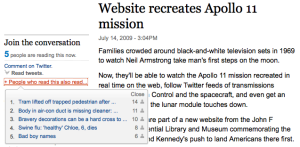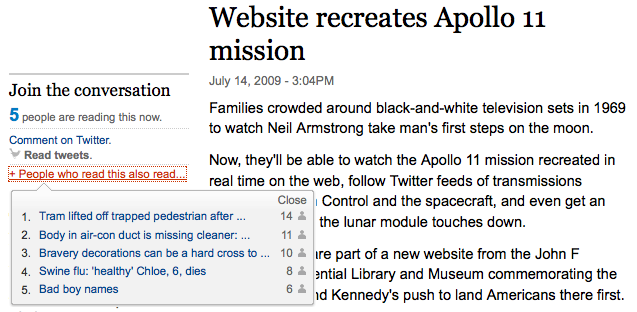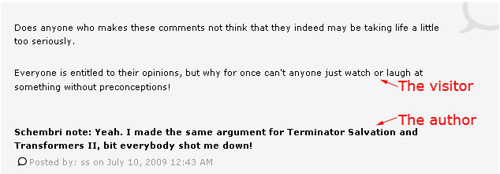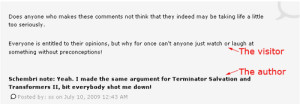The Age newspaper has implemented an interesting social media widget on their article pages. Their 'Join the conversation' widget shows how many people are reading the same article, links to discussion of the page on Twitter, allows the reader to easily add their own comment to Twitter, lists other articles that people who read this article read, and where appropriate, adds a 'Related Coverage' section above the other standard nav links.
I've included a screenshot because I assume attention for each article is fairly transitory so there may not be other readers or twitter discussions on the sample article by the time you read it:
 I'm particularly interested in their approach to Twitter. They've used automatically generated hash tags to group together discussion of each article on Twitter. For example, in this article, 'First climate refugees start move to new island home' the hash tag is '#fd-e06x'. If you use their 'Comment on Twitter' link it automatically sends a status to the Twitter site (if you're logged in) with the article URL and '#fd-e06x'.
I'm particularly interested in their approach to Twitter. They've used automatically generated hash tags to group together discussion of each article on Twitter. For example, in this article, 'First climate refugees start move to new island home' the hash tag is '#fd-e06x'. If you use their 'Comment on Twitter' link it automatically sends a status to the Twitter site (if you're logged in) with the article URL and '#fd-e06x'.
The 'Read tweets' link takes you to the Twitter search page with the pre-populated search term '#fd-e06x'. Of course, the search won't show any discussion about the issues in the article or about the article itself that haven't used their hash tag.
The system also seems to generate a new hash tag for each article, even those that are updates on previous breaking news stories. So these two articles (Woman hit by train fights for life, Woman fights for life after train station accident) about the same incident have different hash tags – perhaps this can be fixed in a later iteration.
I wonder if it would be possible to harvest possible topical tags from other tweets about the article (checking all the various URL shortening services) to suggest more human-friendly tags related to an article? It's probably not worth it for The Age, but it might be for content with a longer life. Or would an organisation be at risk of appearing to endorse those labels?
Interestingly, the pages don't mention the hash tags, so the process is invisible to the user. Would explaining it lead to greater uptake? I use a Twitter client (partly because I can easily shorten long links, while The Age doesn't pre-shorten their links) so would take the URL directly from the location bar, missing out their hash tag.
Selfishly, because I'm thinking about it for work, I'd love to know how they generate their 'other people who read this' and 'Related Coverage' links. I assume the latter is manually generated, either as direct links or based on article or section metadata.
Also selfishly, I'd like to know their motives, and whether they have any metrics for the success of the project.


